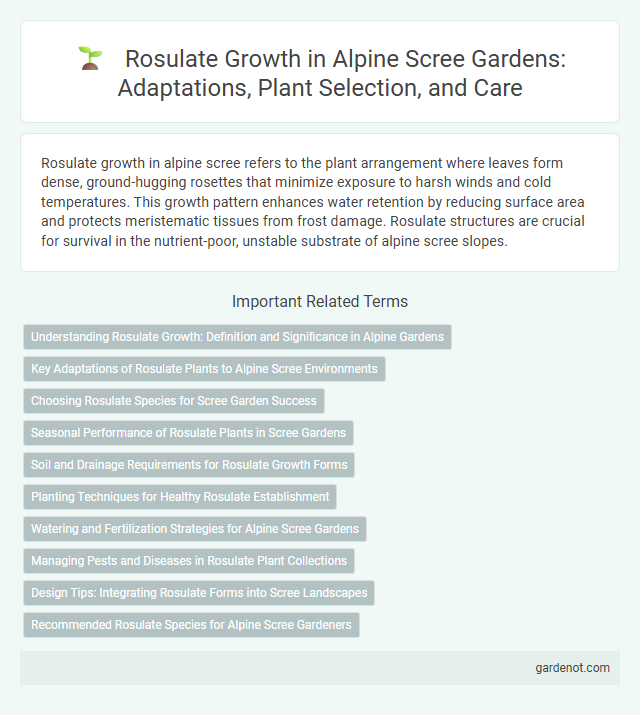Rosulate growth in alpine scree refers to the plant arrangement where leaves form dense, ground-hugging rosettes that minimize exposure to harsh winds and cold temperatures. This growth pattern enhances water retention by reducing surface area and protects meristematic tissues from frost damage. Rosulate structures are crucial for survival in the nutrient-poor, unstable substrate of alpine scree slopes.
Understanding Rosulate Growth: Definition and Significance in Alpine Gardens
Rosulate growth refers to a plant's growth pattern characterized by a dense rosette of leaves arranged in a circular formation close to the ground, optimizing water retention and protection against harsh alpine conditions. This adaptation is significant in alpine gardens as it enhances plant survival on rocky, nutrient-poor scree by minimizing exposure to wind and conserving moisture. Recognizing rosulate growth helps gardeners select species that are naturally suited to alpine scree environments, promoting biodiversity and ecological balance.
Key Adaptations of Rosulate Plants to Alpine Scree Environments
Rosulate plants thrive in alpine scree by forming dense rosettes that minimize water loss and protect meristems from extreme cold and wind. Their compact growth habit reduces exposure to desiccation and mechanical damage caused by shifting rocky substrates. Thick, waxy leaves and deep root systems enhance moisture retention and stability in nutrient-poor, well-drained scree environments.
Choosing Rosulate Species for Scree Garden Success
Selecting rosulate species such as Sempervivum and Saxifraga is crucial for scree garden success due to their adaptive rosette growth form, which conserves water and withstands harsh alpine conditions. These plants' compact morphology limits soil erosion and maximizes rooting stability on rocky slopes, enhancing overall garden resilience. Emphasizing species with drought-tolerant, low-maintenance traits ensures sustainable growth in well-draining, mineral-rich scree environments.
Seasonal Performance of Rosulate Plants in Scree Gardens
Rosulate plants in alpine scree gardens exhibit remarkable seasonal performance, adapting their growth patterns to the harsh mountain environment. These low-growing, tightly packed rosettes maximize water retention and photosynthesis during short growing seasons, thriving in well-drained, nutrient-poor scree soils. Their robust survival strategy includes summer flowering and rapid dormancy initiation in winter, ensuring resilience against temperature fluctuations and soil erosion.
Soil and Drainage Requirements for Rosulate Growth Forms
Rosulate growth forms thrive in well-drained, coarse-textured soils found in alpine scree environments, where mineral-rich substrates provide essential nutrients. These plants require porous soil that prevents water retention and promotes aeration, allowing roots to resist rot and access oxygen efficiently. Adequate drainage is critical to prevent waterlogging, which can be detrimental to the delicate root structures of rosulate alpine species.
Planting Techniques for Healthy Rosulate Establishment
Rosulate growth thrives on well-drained, mineral-rich alpine scree substrates where planting techniques emphasize gentle root insertion to avoid compaction and damage. Utilizing fine, granular soil mixtures mimicking natural scree conditions promotes moisture retention without waterlogging, essential for healthy rosulate establishment. Strategic spacing that mirrors natural colonization patterns enhances air circulation and reduces competition, fostering robust, resilient rosette plants in alpine environments.
Watering and Fertilization Strategies for Alpine Scree Gardens
Rosulate growth in alpine scree gardens demands precise watering practices to replicate natural snowmelt conditions, ensuring moisture retention without waterlogging the shallow, rocky soil. Fertilization strategies emphasize low-nutrient applications using slow-release formulations rich in potassium and phosphorus to support root development while avoiding excessive nitrogen that can promote weak, leggy growth. Careful timing of watering during early morning and using well-draining substrates enhances nutrient uptake and overall plant vitality in these harsh environments.
Managing Pests and Diseases in Rosulate Plant Collections
Managing pests and diseases in rosulate plant collections requires regular monitoring and prompt intervention to prevent infestations from escalating. Employing biological controls such as beneficial predatory insects reduces chemical usage, preserving the delicate balance of alpine scree ecosystems. Ensuring proper air circulation and drainage minimizes fungal infections, promoting healthier rosulate growth in challenging rocky substrates.
Design Tips: Integrating Rosulate Forms into Scree Landscapes
Incorporate rosette-shaped plants with compact, low-growing forms to stabilize alpine scree slopes while enhancing visual texture. Select species with dense leaf clusters that mimic the natural composition of scree, such as Saxifraga and Sempervivum, to promote erosion control and biodiversity. Use varied plant sizes and colors to create naturalistic patterns that blend seamlessly with rocky substrates and optimize moisture retention.
Recommended Rosulate Species for Alpine Scree Gardeners
Recommended rosulate species for alpine scree gardeners include Sempervivum, Saxifraga, and Androsace due to their compact rosette forms and drought tolerance. Sempervivum tectorum thrives in well-drained, rocky soils and withstands freezing temperatures, making it ideal for high-altitude scree environments. Saxifraga oppositifolia and Androsace helvetica provide vibrant blooms and form dense mats that stabilize loose scree substrates while enhancing biodiversity.
Rosulate growth Infographic

 gardenot.com
gardenot.com